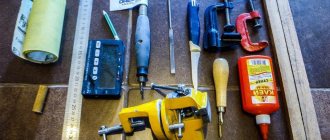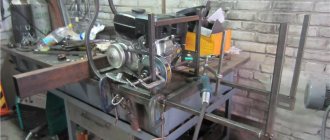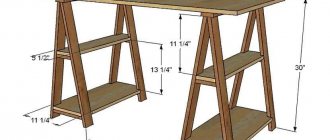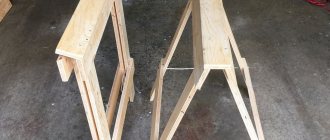Dmitrij 1-10-2015, 04:05 6 859 Robots
This article will talk about how you can make a miniature vibration robot with your own hands. When turned on on a smooth surface, such robots begin to dance, making circles on the table. This is explained by the fact that an unbalanced weight is installed on the engine, which creates vibrations. Anyone can assemble such a robot at home; this requires a minimum of skills and materials.
This particular robot model is called Itty Bitty. The vibration motor from an old mobile phone is used as the “heart”, and the robot is powered by a 3V watch battery.
Materials and tools for creating a robot:
- 3V flat battery; - vibration motor from an old mobile phone; - one large paper clip; - soldering iron along with solder and flux; - electrical tape; - hot melt adhesive; - dark marker.
Tools you will need are a file, alcohol and pliers.
Robot manufacturing process:
Step one. Creating robot legs
Creating the robot's legs is the most crucial moment in this whole matter. The work of the entire robot will depend on how correctly they are done. First of all, the legs must be strong, since the robot will jump quite strongly when vibrating. They are made from a single piece of wire. A paper clip is best suited for this purpose.
First of all, it needs to be straightened and then divided into 6 equal parts. Each individual piece will end up being 1/16″ long. An important point when working with a paper clip is the smoothness of your movements. If you bend a paperclip too quickly, it may break. If the corners are more than 90 degrees, they need to be made rounded. Now you need to take one mark and bend the paperclip 90 degrees at this point, at the other mark you need to bend it in the opposite direction. If the end of the paper clip is rounded when bent, this significantly reduces the likelihood of fracture. On the third mark you need to make a 90 degree bend, but the bend should be as far from the end as possible. At the fourth mark, a 180-degree bend is made, the end should be at the back. A 90-degree bend is made on the fifth leg, and it should be as far away from the other two adjacent legs as possible. Finally, the legs need to be adjusted so that they all touch the floor evenly.
Step two. Engine Installation
The battery acts as a supporting element in such a robot.
You need to take a tremo-glue and glue the vibration motor to it. After this, one of the motor wires needs to be soldered to the battery contact, this will be the top contact. In order for the solder to adhere, the battery needs to be scratched a little, this can be done with a file. Step three.
Gluing the Legs Now all that remains is to glue the legs to the robot. To do this, you need to place the battery on the table and place the robot's legs on top of it. Next, the legs need to be pressed down; to do this, you can place a linear level or a piece of aluminum on the legs. Before applying glue, it is advisable to degrease the battery surface with alcohol. There is no need to spare glue, since when working, quite a lot of force is applied to the legs. If you glue the legs poorly, the robot may fall apart during operation. There is no need to rush to start the robot, the glue must harden securely. The author recommends putting the workpiece in the refrigerator, so the glue will dry faster. That's all, the robot is ready and you can check it. To turn on the robot, you need to take a piece of electrical tape and glue the second wire from the motor to the battery contact. By placing the robot on a smooth table, you can now observe what it will do. Source
Become the author of the site, publish your own articles, descriptions of homemade products and pay for the text. Read more here.
Idea
Description
Execution
Final grade: 0.0
Source: https://USamodelkina.ru/6366-delaem-prostogo-miniatyurnogo-vibro-robota.html
Purpose of vibrating plates
A vibrating plate is a mechanism designed to compact loose soils and bulk building materials. In addition, such a mechanism is widely used for vibration processing of semi-dry concrete mixtures and asphalt when constructing floors and paving surfaces. The use of such a tool is very effective when working on a small plot of land and in cramped spaces.
Homemade electric vibrating plate.
The construction of sidewalks, garden paths, driveways and parking lots near a private house using a vibrating plate is carried out much faster, while ensuring high quality of work. Compacting the bottom of the trenches when laying utilities eliminates their possible damage in the event of subsidence of loose soil. These and other advantages encourage many home craftsmen to make such equipment themselves and use it in construction work.
DIY robot mantis made from a mouse
The project is intended for those who are familiar with the basics of robotics and are well versed with electronic devices.
Advantages of a homemade tamping machine
The main advantage of a home-made vibrating plate is its low cost and the ability to perform high-quality and efficient work. The simple design ensures the reliability and durability of the mechanism. In addition, a homemade vibrating plate allows you to:
- Safely tamp any surfaces;
- reduce the amount of manual labor when performing work;
- improve the quality of footpaths and platforms;
- It is good to compact dry cement and semi-dry concrete mixtures when laying them.
Having a mechanism for compacting loose soils and bulk materials will allow you to carry out any amount of landscaping and exterior design work.
Review of purchasing options.
Materials used
A suitable material for homemade manual tamping is a square beam with a side of 100 or 150 mm. It will be difficult to work with a round log in the corners and will have to be compacted with a significant overlap of the previous impact point.
It is not at all necessary to take new lumber; a used lumber will do. The main thing is that the wood is free from rot and splits. Choose a piece of timber that you can lift. The height of the manual tamper can be waist-high or chest-high, depending on ease of use. If you have no experience working with this tool, take a longer block, try it out and shorten it if necessary.
Drawing of a manual tamper for soil compaction.
Materials for the manufacture of manual soil compaction.
Mechanism design
The main working element is a heavy metal platform, which can be made of gray ductile iron or steel. The vibration effect on it is transmitted from a mechanical vibrator driven by a gasoline, diesel or electric engine.
Drawing of a homemade vibrating plate.
A durable handle is provided to control the vibrating plate as it moves across the work area. Additionally, the design may include a fuel tank or starting electrical equipment. The engine and vibration device are installed on a frame, which is mounted directly on the tamping platform.
Peculiarities
Compaction of soil, backfill layer or concrete casting during construction work requires the participation of special equipment. In private construction, problems often arise related to deformation or subsidence of the foundation.
- The cause of these events is poor compaction of the sand backfill layer. According to the technology, the density should correspond to the condition of a long-used country road. Checking the quality of the compaction is usually done by walking along the compacted area - if there are no traces of shoes left, the job has been done to the proper standard.
- Soil compaction is required not only in critical areas. Conventional tiling of garden paths requires the creation of a layer of sand cushion, which also requires the maximum degree of compaction, otherwise the coating will begin to fail and move apart. It is impossible to achieve high quality work manually, and a vibrating plate comes to the rescue.
- For home use, not everyone can purchase a ready-made device, since the cheapest sample will cost 20 thousand rubles. People who are able to operate metalworking tools and a welding inverter prefer to make their own vibrating plates, which saves money and brings the desired result.
Making a tamping plate
The plate for the vibrating tamper can be manufactured at the factory or made by hand from a metal sheet with a thickness of at least 8 mm. A homemade vibrating plate should provide such a weight to the device that it will give a tight fit to the surface being treated.
Its dimensions should not exceed 800 x 500 mm, excluding the curved edge, which will ensure convenient operation and the ability to use the device without additional assistants.
A flat steel plate, when moving over soil or concrete mixture, will constantly cling to an uneven surface. To avoid this, the front and rear edges of the slab are slightly bent upward, resulting in a structure reminiscent of a sled. To do this, stepping back a little from the edge, you need to make a cut in the metal to a depth of 5-6 mm using a grinder and bend the strip. Repeat this operation on the other edge of the sheet. The contact line after the bend must be welded using electric welding.
Making a tamping plate.
To install the motor and vibration mechanism on the platform, you need to secure the support frame. It can be made from two installed pieces of metal channel. They must be installed parallel to each other transverse to the axis of the tamping platform. Drill mounting holes for the motor and vibrator in them and weld them with electric welding.
Creating a sand-cement cushion
Follow this procedure:
- We sift the sand and mix it with cement in a ratio of 6 to 1. This is easiest to do in a concrete mixer.
- We fill the area with a 10-centimeter layer (taking into account the thickness of the tiles). This means that the thickness of the tile + the thickness of the pillow should be 2 centimeters above the red mark (shrinkage cap).
- Using a vibrating plate or a stomp (a shelf with a nailed wide board and a pile plank) we tamp the entire area.
- Check the tension of the red marks and the presence of slope.
- We lay out beacons (pipes with a diameter of 20 millimeters) around the site. They should be pressed firmly onto the pillow. The distance from the lace to the beacon should be the same as the thickness of your tile, plus 1 centimeter for compaction.
- Now we take the trapezoidal rule and, focusing on the beacons, we tighten the excess part of the sand-cement cushion to obtain a perfectly flat surface.
- We take out the first beacons, on the side where you will start laying the tiles. Fill the grooves with the same mixture and begin laying the tiles.
Engine selection and installation
When making a vibrating plate with your own hands, diesel engines are usually not used. Yes, they are reliable and durable, diesel fuel is cheaper than gasoline, but these engines are too expensive and bulky for a small home machine. The most popular mechanisms are those with a gasoline internal combustion engine and with an electric drive.
The gasoline engine makes it possible to perform work regardless of the presence of a nearby energy source. This vibrating plate is in demand among small construction teams performing contract work on private development sites.
To carry out work within the personal territory, it is better to use a tamping machine with a 220V electric motor. It operates much quieter, does not require refueling, and the power supply can be easily provided through an extension cord that can be extended to any location on the site.
The electric motor is fixed to a welded channel using bolts and connected to the vibration mechanism using a belt drive. If the vibrator eccentric is connected to the motor with a rigid connection or mounted on a shaft, then the motor bearings will constantly fail due to vibration effects.
The structure of the model with a gasoline engine.
The center of gravity of the engine must be on the central axis of the vibration platform. If this is not done, then during operation the vibrating plate made by yourself will constantly move to the side and you will have to make additional efforts to keep it in the desired direction. Vibration-damping pads made of thick rubber must be placed under the motor feet.
UAZ 31519 will be Red › Logbook › Floating fault
Hi all!
I periodically had a floating fault. The first time we were sitting in the car near the garage, the car was idling and BAM - it stalled. I ran around the car, started it - it worked, then BAM and again. In general, the car stood, I started it - everything worked (I thought it was the gas pump, since the car had previously run on gas). I went for probably a month.
The second - I drive 20 meters away from the store, and again BAM and it stalls... This time I already had a fine filter installed, and I determined from it that there was fuel and it was coming. It stood for about 5 minutes while I was under the hood, I started it up and it worked. I drove about 5 meters and again the song is the same... After a couple of minutes I start it up - it works, while we were standing there talking to a friend, after about 5 minutes it takes off again and stalls. I get into the car, start it and drive it for a week...
The third time - I went to get the Hyundai out of the snow captivity, pulled it out, they stood smoking, the car was also idling, I got in, drove a couple of kilometers and again the same crap. Well, we already know what to do, or rather what not to do - five minutes pass, we launch and drive 50 meters... we stand. This time, when I started it again, the car started to stall, well, I think it means something has finally come to fruition. I connect the green wire from the switch to the emergency ignition distribution, when the ignition is turned on, it starts to buzz, the engine starts, runs for 20 seconds and stalls. Second try, nothing happens and the sound is gone. I look at the Gas-gasoline switch, but the “gasoline” light on it is not on, I click on gas (let me remind you that I turned off the gas system, closed the taps, removed the fuel supply shut-off valve.) I switched to “GAS”, the vibrator vibrated, the car started working and arrived safely at the parking lot. Yesterday I went to the store and bought a switch, an additional resistance, a coil (I didn’t take the distributor - later I’ll take a new one from a friend from the USSR reserves) I didn’t install anything right away, I returned the green wire to its place on the switch, I started it and, voila, everything works — the reason is somewhere in the wiring, we’ll look and figure it out, and the spare parts haven’t bothered anyone yet — they’ll ride with me and it’ll be calmer.
“In case of failure in the ignition system path, it is advisable to have an emergency vibrator. The vibrator installed on UAZ vehicles (models 5102.3747) is a conventional electromagnetic relay, the opening contacts of which are shunted by capacitors. Due to this, when DC voltage is applied to the relay, its contacts open and close at a certain frequency. If it is connected to the primary winding of the ignition coil instead of the sensor and commutator, then the vibrator will perform the function of these elements of the ignition system, i.e. periodically interrupt the circuit of the primary winding. However, the interruption will not be synchronized with the angular position of the engine crankshaft. But this does not matter - the frequency of operation of the vibrator relay is such that the working mixture is ignited in all cylinders of the engine during the compression stroke. In other words, when an emergency vibrator is connected, the engine will operate, but not in optimal mode. But you will be able to get to the garage without any problems and independently diagnose and repair the ignition system.”
Source
Vibration mechanism
The simplest device for creating vibration vibrations can be made from a piece of metal circle with a diameter of 40-65 mm. To do this, a hole with a diameter of 12-14 mm is drilled parallel to its axis along the entire length. It should be offset from the center by about half the radius. A metal rod of the appropriate diameter must be inserted into this hole and firmly secured with nuts.
Bearings or bronze bushings are installed on the same shaft-rod on both sides, mounted on racks welded to the channel. The height of the stands depends on the diameter of the vibrating roller. On the belt drive side, a pulley is attached to transmit rotational motion from the electric motor to the vibrator. Rotating at high speed, this roller with a shifted center of gravity will create oscillatory movements and transmit them through the racks to the vibrating platform.
Electric vibratory rammer circuit diagram.
You can use a factory-made vibration mechanism. This will provide a higher level of machine reliability, but will entail additional costs.
What is a vibrating plate?
Why do you need a vibrating plate?
The processes of compacting various loose bases are integral to construction work. For example, crushed stone, sand, soil and other similar materials.
Basically, these are the stages of preparation for pouring concrete, asphalt, laying tiles or building a foundation.
In order to mechanize the compaction process, so-called vibrating plates are used. The mechanism of their action is quite simple.
The device creates vibrations under the action of which small particles of the compacting layer are knocked as close to each other as possible, excess air is displaced and at the finish a flat base of the required density is obtained.
Buying such a car for yourself is quite unprofitable. A homemade vibrating plate will cost much more profitably.
Structural structure of the mechanism
A vibrator is mounted on a weighty platform, and a motor is installed above it. The last two nodes are connected by a coupling and a V-belt drive.
The rotational movements of the engine are converted into oscillatory movements using a vibrator and transmitted to a heavy platform, which in turn acts on the compacted surface.
The device's reverse function makes it possible to perform work in narrow trenches and pits.
The stove itself is made of steel or cast iron, preferably of good quality. Otherwise, the service life of the device is significantly reduced, and cracks appear on the surface of the base.
The size of the working surface of the slab affects the pressure exerted by the mechanism on the compacted layer. A slab with a smaller area compacts the soil better.
The density of the finishing layer depends on the vibration force. The higher it is, the better the material is compacted.
Vibrating plate configuration options
Nutrition classification
- electrical,
- diesel and
- gasoline vibrating plate.
Electric. Electric is considered the most economical. This is exactly what they recommend collecting with your own hands for your own household.
Moreover, in terms of technical characteristics, vibrating plates with an electric motor are in no way inferior to their competitors. The only downside is the condition of having an accessible electrical network.
Gasoline. It will cost more than electric ones, but cheaper than diesel ones.
However, it will be more profitable to buy fuel for diesel engines, although the engine itself will be the most expensive of the three described.
Also, its disadvantage will be high noise, which reduces comfort at work.
The power of the installed motor must be sufficient to operate a heavy slab. Otherwise, the latter will load in bulk material.
Classification by weight
Highlight:
- Lightweight slabs. Weighing 75 kg. For processing layers up to 15 cm thick. Such slabs are used for landscaping work, laying paving slabs, and damping polyurethane mats.
- Universal plates. Their weight ranges from 75 to 90 kg. The maximum layer to be treated is 25 cm. They are used for landscape work, repair of road surfaces, including patching on asphalt.
- Medium-heavy. Weight 90-140 kg. The thickness of the treated layer is up to 60 cm. Application - laying road surfaces in layers, backfilling trenches along the perimeter of the foundation.
Classification by direction of movement
According to the direction of movement during the compaction process, vibrating plates can be straight or reverse.
Straight lines can only move forward, and if a second pass over the compacted layer is necessary, such a machine will have to be turned around. And this, albeit small, is still a waste of time.
Reversible vibrating plates can move both forward and backward. They give higher performance. Typically, devices with slabs weighing more than 100 kg are equipped with reverse.
Additions to the package
An additional advantage would be if the vibrating plate is equipped with an irrigation system.
It protects the unit from sticking to the compacted surface. They should carefully protect the engine from water.
This way, small particles of bulk materials will not clog into the mechanism, and the machine itself will last much longer.
Torque transmission
It is recommended to use a soft V-belt drive as a transmission to transmit torque from the engine to the vibration mechanism. It will ensure reliable rotation of the eccentric and protect the motor bearings from the effects of vibration.
It is recommended to use double-belt pulleys. This will give greater grip to the belts and ensure trouble-free operation in the event of a break in one of the belts.
To protect against possible injuries, the belt drive must be covered with a protective cover, and if this cannot be done, then a bumper guard must be installed.
Useful features
All vibration installations have additional devices that make work easier or provide additional protection. In order to move the device to a new place of work, the presence of wheels and a folding handle will make this task performed without unnecessary effort.
Various covers will protect the machine from particles from the compacted surface. The slab wetting system is effective when rolling hot asphalt. Without it, it will stick to the top layer.
Work to strengthen the bottom of trenches or compact soil in narrow places is practically impossible without ensuring reverse movement.
Control handle and vibration damping system
During operation, thanks to the front location of the eccentric and the resulting vibrations, the platform with the engine installed on it begins to move along the surface independently. But to set the correct direction of movement, a control handle is needed.
According to its design, it can have one or two inclined posts with a transverse handle-crossbar. It is recommended to install a vibration damping device in the upper part of the handle so that vibrations are not transmitted to the hands during operation. You can use springs as protection; the stand itself can be made of two pipes, one of which will go inside the other. The springs are fixed by steel rings installed on the pipes.
If you have the financial opportunity, then instead of a homemade spring structure, you can install silent blocks from a passenger car. This will provide sufficient vibration damping, and the structure itself will be less noisy.
Make a shoe
Transfer the dimensions of the workpiece from the drawing to the steel sheet.
Cut out the plates for the shoe.
You can simply align the timber vertically installed on the metal and trace the outline with a pencil.
We make a soil compactor shoe.
Depending on the thickness of the plate, cut the workpiece with metal scissors or cut out the excess with a grinder. Remove burrs with a file, holding the part in a vice.
Mark and drill holes for the screws, make recesses for the caps with a countersink or a drill of a larger diameter.
Sand the surfaces with sandpaper.
Tamping shoe.
Bend the wings of the workpiece in a vice, which will be easy to do with the first two opposite sides. When bending the two remaining sides, the vise jaws may turn out to be wider than the shoe, then use a timber prepared for tamping.
Possibility of reverse movement
Movements of a homemade vibrating plate made as described above are only possible in one direction. Therefore, after walking a certain distance, you have to turn it around and only then move in the opposite direction. This reduces the speed of work and requires additional physical effort on the part of the operator.
Another drawing of a variant with a gasoline engine.
In order to provide the vibration machine with the ability to reverse movement, it is necessary to install a device that changes the direction of rotation of the motor. After its installation and connection, the vibrating plate will be able to move in two directions.
When the edge of the treated area is reached, the operator turns off the engine and starts rotating it in the opposite direction. The vibrator eccentric will also become reversible and provide the machine with a return movement.
Operating principle
The operation of a vibrating plate is based on the use of a rotating shaft with an eccentric, which generates strong vibration. The shaft is mounted on a massive metal base, which with its weight acts on the soil, compacting it due to its weight.
On the same base, a motor is installed, which is necessary to drive the eccentric shaft into rotation. To control the structure and give the installation the desired direction, a long handle is installed.
There are several types of vibrating plates:
- electrical;
- diesel;
- gasoline.
By weight they are divided into:
- light (up to 75 kg);
- universal (from 75 to 90 kg);
- medium-heavy (from 90 to 140 kg);
- heavy (140-200 kg or more).
There are also different ways to move the vibrating plate:
- upright, capable of moving only forward and requiring a platform of sufficient size to turn around;
- reversible, capable of moving both forward and backward, which makes them more convenient in conditions of limited space.
Lightweight and versatile vibrating plates are used for compacting paths, paving slabs, and landscaping work. During construction and foundation work, medium-heavy and heavy-duty installations are required that provide maximum compaction combined with high productivity.
Important! The weight of a vibrating plate created at home should not be too large, otherwise it will be difficult to move it and there will be a danger for the worker servicing the installation.
Final work
After assembling the slab, all metal parts must be primed and painted to protect against corrosion. Securely fasten the supply cable to the control handle to prevent the possibility of running over it. The engine switch must be located on the structure itself to provide an emergency stop during operation.
After this, the vibrating plate made by yourself must be tested. Freshly dug soil is best suited for this. Testing on bulk material will not allow you to test operation at full load.
As you can see, it is quite possible to make a vibration machine yourself. But for this you need to have basic knowledge and experience in plumbing and welding.
Robot vibration walker
The Master's Secret continues the theme of making simple robots. Let's assemble the simplest mobile solar robot. Materials are available and costs are minimal.
How to make a robot vibration walker with your own hands
To assemble the robot, you will need the following tools: a soldering iron, a hot-melt gun, a jigsaw and wire cutters. The components of the robot are as follows. The heart of the robot is a vibration motor, the part is removed from a broken cell phone or pager.
It should be noted that motors from different phone models operate differently. The most efficient engine was extracted from a Samsung phone. The robot's mover is a toothbrush, or rather a head with bristles (separated from the handle with pliers).
The lab looked at various options for available solar panels. The optimal and budget option was chosen to use solar panels from garden lights. Preference should be given to elements with a silicon solar battery.
Film solar cells have a lower output current when converting solar energy. See photos and videos.
Vibration motor donorOn-board vibration motorVibration motorTwo types of batteriesSilicon batterySolar cell
Assembly diagram
The motor is secured with hot glue to the toothbrush; the weight on the motor axis should be in free space and protrude slightly outward. The solar cell is cut from a garden lamp using a jigsaw. Using the conductors of the solar battery, we supply power to the vibration motor.
For better stability of operation from a solar battery, you can solder an electrolytic capacitor in parallel to the power circuit (observe polarity!). The solar battery is secured with hot-melt adhesive; symmetry must be observed during fastening, which will increase the stability of the structure when moving.
The vibration motor is fixed. The power conductors are soldered. The vibration walker robot is assembled. Tests in the sun. Tests on a cat. Robot cockroach.
Tests can be carried out by illuminating the robot with a small spotlight.
In normal sunlight, the robot runs quite quickly.
Don’t forget to subscribe to updates on the Sekret-mastera.ru website, share the link to the Secret Master website with a friend, and we also invite you to visit the Sekretmastera video channel on YouTube and also become its subscriber.
Source: https://sekret-mastera.ru/bez-rubriki/robot-vibroxod.html
Operating rules
Any person wants his equipment to work as long as possible and not break down. In the case of a vibration device, for this you need to follow the rules that apply to both a homemade device and a branded one:
- Each time before starting work, it is necessary to meticulously inspect the device. If you find cracks or loose connections, do not start using the equipment until the defects are eliminated.
- The gasoline engine requires maintenance more than other components. Inspection and cleaning of spark plugs and checking the oil level must be carried out regularly.
- The vibration unit also requires attention. If there is no oil, eccentrics and bearings fail.
- The device itself must be cleaned of dirt.
- Do not transport the vibrator while it is running.
- It is prohibited to use the equipment on hardened asphalt or concrete.
Purchasing a unit
If you still decide to purchase a unit, you need to take into account both the main criteria and minor nuances that will make the work easier or increase its service life. However, we cannot fail to mention the manufacturers of vibratory ramming devices.
- Equipment from European manufacturers is especially important. German technology is distinguished by its reliability and long service life. Even rental samples show good quality and speed of work. All equipment has a double safety margin. Wacker, Weber, Ammann, Bomag produce professional equipment.
- Israeli Shatal and Czech NTC have fewer resources than the Germans, but they also turn out to be good workers at construction sites and on private property.
- South Korean equipment from Jeonil Minery is not inferior to products from the Czech Republic or Israel. In the Asian market, this is the best offer among all vibration units.
- Russian products from, Motoprom and SZPO are inferior to average European models in terms of convenience and functionality. However, modernization continues, and new, more advanced models appear on sale.
- The Chinese, as usual, charge a price. Their products are only suitable for occasional, light-duty work. Among the mass of unknown manufacturers, the companies TEKPACK, MASALTA, DYNAMIC, CIMAR stand out.











